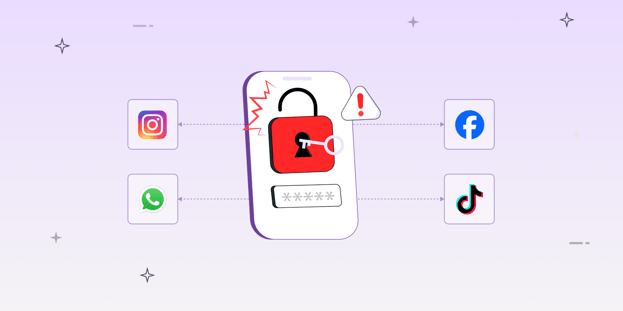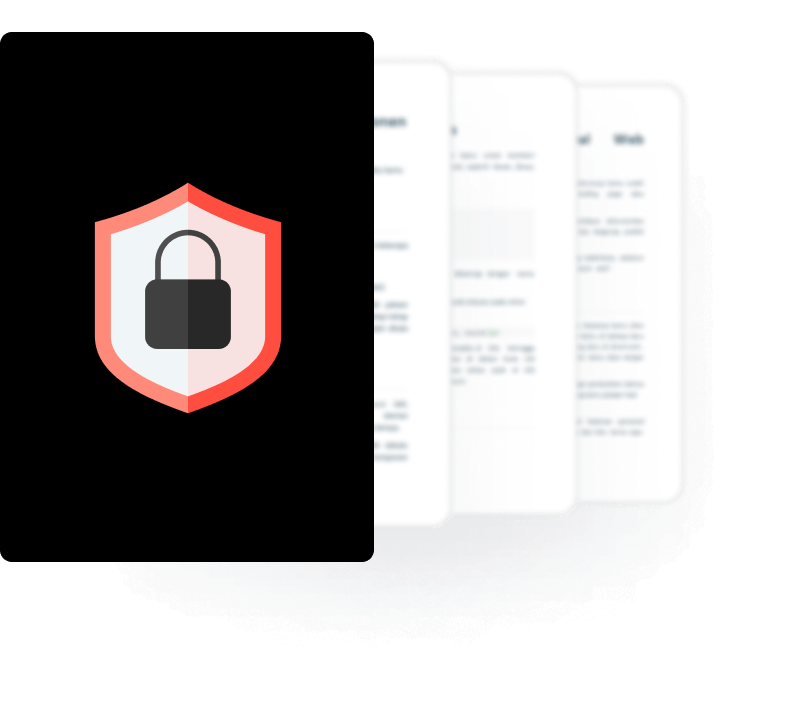
BLOG

BLOG
If mobile apps were high school stereotypes, social media would be the popular kid everyone gossips about, but secretly rolls their eyes at. Everyone uses them, everyone knows the risks, and yet everyone keeps showing up at their parties.
In our consumer survey earlier this year, 56% of U.S. respondents said they trust social media apps the least with their personal data. Not banks, not e-commerce sites - social media. And yet, TikTok, Instagram, Facebook, WhatsApp, and Telegram remain among the most downloaded apps in America.
To see whether that distrust was justified, Appknox’s security research team put these apps under the microscope. Using a combination of static application security testing (SAST), dynamic application security testing (DAST), API analysis, and runtime protection assessments, we examined how the most popular social and messaging platforms actually handle user data and defend against common threats.
56% of U.S. users distrust social media apps the most with their personal data—yet TikTok, WhatsApp & Instagram still dominate downloads.
80% of tested apps asked for unnecessary permissions (like mic & location), creating a built-in surveillance risk.
3 out of 5 apps lacked runtime protections, leaving them vulnerable to cloning, tampering & malware-packed “mod” versions.
Unencrypted local storage in popular apps exposes session tokens & media files—making account takeovers easier than users think.
API vulnerabilities leak metadata (who you talk to, when, how often), which is as valuable to attackers as actual messages.
Bottom line: Social media apps are privacy black holes, users know the risks, but dependence keeps them hooked.
Every single app we tested asked for high-risk permissions: microphone, camera, contacts, location, and even when those permissions weren’t necessary for the app’s core functions.
Unnecessary permissions create a surveillance-ready environment where apps can track your movements, map your contacts, or listen in through the microphone.
Malicious or trojanized app versions can abuse microphone access for stealth recording or location tracking for stalking.
TikTok has faced repeated regulatory scrutiny in the U.S. and Europe for requesting permissions that far exceeded functional need, raising questions about persistent data collection practices.
80% of the apps requested permissions that exceeded necessity. That’s not accidental; it’s a design choice.
Three out of five apps had inadequate protection against reverse engineering.
Without runtime defenses, attackers can peel apart the app, tamper with its code, or build counterfeit versions.
Fake “mods” of WhatsApp and Telegram circulate widely, often packed with spyware or adware. These clones trick users into downloading apps that look legitimate but quietly harvest data.
WhatsApp Pink, a trojanized version promising new features, spread across Android stores in 2021, infecting thousands of users. Its existence underscores how weak runtime protections make cloning dangerous and straightforward.
Two apps cached session tokens and media files on devices without proper encryption.
Storing sensitive data in plaintext is like leaving your car unlocked with the keys on the seat. Anyone with local access—through theft, malware, or shared devices—can take over your accounts.
Malware can sweep unencrypted cache folders to hijack active sessions or exfiltrate private media.
In 2020, researchers found Telegram’s desktop client cached “deleted” messages and media in unencrypted folders, allowing forensic recovery. On mobile, the same oversight can expose personal data to attackers.
Two apps exposed API endpoints without proper authentication, leaking metadata such as contact references and message timestamps.
Even if messages are encrypted, metadata reveals who you’re talking to, when, and how often. For attackers, governments, or advertisers, this social graph is as valuable as the content itself.
API scraping can be used to profile activists, journalists, or executives—without ever reading a single message.
In 2022, an encrypted messaging app suffered a metadata exposure breach. Attackers mapped user activity and relationships through unsecured APIs, proving that “secure messages” are meaningless if the metadata leaks.
|
Risk area |
What we found |
Impact on users & businesses |
Real-world case example |
|
Excessive permissions |
80% requested unnecessary access |
Creates a surveillance-ready environment where movements & conversations can be tracked. |
TikTok flagged by U.S. & EU regulators for requesting unnecessary mic & location access. |
|
Weak runtime protections |
3 of 5 apps lacked runtime defenses |
Allows attackers to reverse-engineer apps, inject spyware, and trick users with fake versions. |
WhatsApp Pink (2021) – a trojanized clone spread widely, stealing user data. |
|
Unencrypted local storage |
2 apps cached sensitive data unencrypted |
Sensitive data (tokens, media) can be hijacked, like leaving car keys in the ignition. |
Telegram desktop client cached “deleted” messages unencrypted (2020). |
|
Exposed APIs |
Exposed endpoints leaked metadata |
Users trade privacy for convenience, staying locked into ecosystems despite knowing the risks. |
Instagram & TikTok’s attention-driven algorithms. |
The survey-vs-testing gap is telling. People know these apps are dangerous. They don’t trust them.
And yet, usage is higher than ever. Why?
You can’t just leave WhatsApp if your family group, sports team, and work colleagues all rely on it.
Instagram and TikTok are built for attention capture; privacy is never the priority.
When faced with instant communication vs. abstract security risks, convenience usually wins.
This creates a perfect storm: apps that are the least trusted are also the most indispensable.

Social media and messaging apps are no longer just platforms; they are the infrastructure of modern communication. They shape politics, business, friendships, and culture.
But dominance comes at a cost.
These apps sit at the intersection of
They are privacy black holes: once your data goes in, it’s nearly impossible to get it back.
The paradox is stark: we distrust them, but we depend on them.
Until users demand better safeguards or regulators step in, social platforms will continue to extract, expose, and profit from the data we reluctantly hand over.
Behind every “like,” every blue tick, and every disappearing story lies an app architecture that collects, stores, and leaks more than most users realize.
Until privacy becomes a competitive feature rather than a casualty of growth, users will remain the product and attackers will remain the beneficiaries.
Social media isn’t just where privacy goes to die; it’s where it’s being actively buried.
Frequently Asked Questions (FAQs)
Social media and messaging apps are considered high risk from a security perspective because they request excessive permissions (mic, location, contacts), store unencrypted data, and often have weak runtime protections, making them easy targets for attackers.
You face risks such as data leakage, compliance violations, and metadata exposure. Even if messages are encrypted, unauthorized APIs or cached files can expose sensitive business interactions.
Non-compliance with GDPR, HIPAA, PCI DSS, and similar frameworks can result in multi-million-dollar fines if sensitive data is exposed through insecure apps.
Users continue using apps they don't trust because of network effects (friends/family groups), addictive UX, and convenience. This makes enterprise-level governance and enforced app policies even more critical.
Appknox offers automated SAST, DAST, and API security testing integrated into your DevSecOps pipeline, giving you complete visibility into vulnerabilities before attackers find them.
Consumer app risks affect personal privacy, while enterprise app risks can impact brand reputation, compliance status, and even financial stability through targeted exploits.

